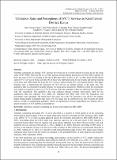| dc.contributor.author | Epule, Epule Terence | |
| dc.contributor.author | Mirielle, Moto Wase | |
| dc.contributor.author | Peng, Changhui | |
| dc.contributor.author | Nguh, Balgah Sounders | |
| dc.contributor.author | Nyagero, Josephat M. | |
| dc.contributor.author | Lakati, Alice | |
| dc.contributor.author | Mafany, Ndiva Mongoh | |
| dc.date.accessioned | 2021-08-27T13:40:45Z | |
| dc.date.available | 2021-08-27T13:40:45Z | |
| dc.date.issued | 11/1/2012 | |
| dc.identifier.citation | Epule ET, Mirielle MW, Peng C, Nguh BS, Nyagero JM, Lakati A, Mafany NM. Utilization rates and perceptions of (VCT) services in Kisii Central District, Kenya. Glob J Health Sci. 2012 Nov 1;5(1):35-43. doi: 10.5539/gjhs.v5n1p35. PMID: 23283034; PMCID: PMC4777010. | en_US |
| dc.identifier.issn | 1916-9744 | |
| dc.identifier.uri | http://repository.amref.org/handle/123456789/170 | |
| dc.description.abstract | Voluntary counseling and testing (VCT) services have been set up in most Districts in Kenya due to the rising
surge of HIV/AIDS. However, the use of these services among married persons has not been fully explored. In
Kissi, the issue of VCT is pressing as the rate of HIV prevalence is close to 3%. In 2006, about 20 000 clients
came for VCT services in Kenya yet only 165 of these were married persons. In the Keumbu sub-district hospital,
of the more than 1000 clients that came for VCT services, approximately 29% were married persons. This paper
therefore aims at determining the utilization of VCT services by married persons in the study area. The
qualitative data was obtained principally through two focus group discussions (FGDs) in which the respondents
were asked to comment on their use of VCT services while the quantitative data was obtained from interviews
with 245 respondents. The qualitative data was analyzed through verbatim transcription while for the
quantitative data; the responses were coded and populated into SPSS from which the frequencies and
percentages were calculated. The results show that actual use of the VCT services is low (28.1%) but slightly
higher among female respondents than males. The low usage may be attributed to (a) fear of results, (b) death
anxiety, (c) lack of confidentiality and lastly, (d) fear of stigmatization. Female respondents were found to have a
greater awareness of VCT and thus its potential use. | en_US |
| dc.description.sponsorship | African Medical and Research Foundation | en_US |
| dc.language.iso | en | en_US |
| dc.publisher | Canadian Center of Science and Education | en_US |
| dc.subject | Utilization | en_US |
| dc.subject | Voluntary counseling and testing | en_US |
| dc.subject | Married persons | en_US |
| dc.subject | HIV/AIDS | en_US |
| dc.title | Utilization Rates and Perceptions of (VCT) Services in Kisii Central District, Kenya | en_US |
| dc.type | Article, Journal | en_US |

